Homemade Sourdough Bagels – With Video
Sourdough bagels are chewy, crusty and properly dense. They have an extra deep flavor thanks to the sourdough starter in the recipe. This recipe take more than 12 hours to make, but the vast majority of the time is hands-off.

I’ve said it before, I think a good bagel should have a nicely dense and chewy texture with a toothsome crust. Forget the frozen hockey pucks from the grocery store, and the bagels from chain bakeries that are way too fluffy to be a real bagel.
Homemade bagels are not hard to make and they freeze beautifully. If you set aside a little time over a weekend, you can stock up the freezer for weeks to come.
This Sourdough Bagel recipe is a variation of my popular recipe for New York Style Bagels.
If you don’t already have one, I can show you how to make a sourdough starter and how to feed a sourdough starter.
Ingredients
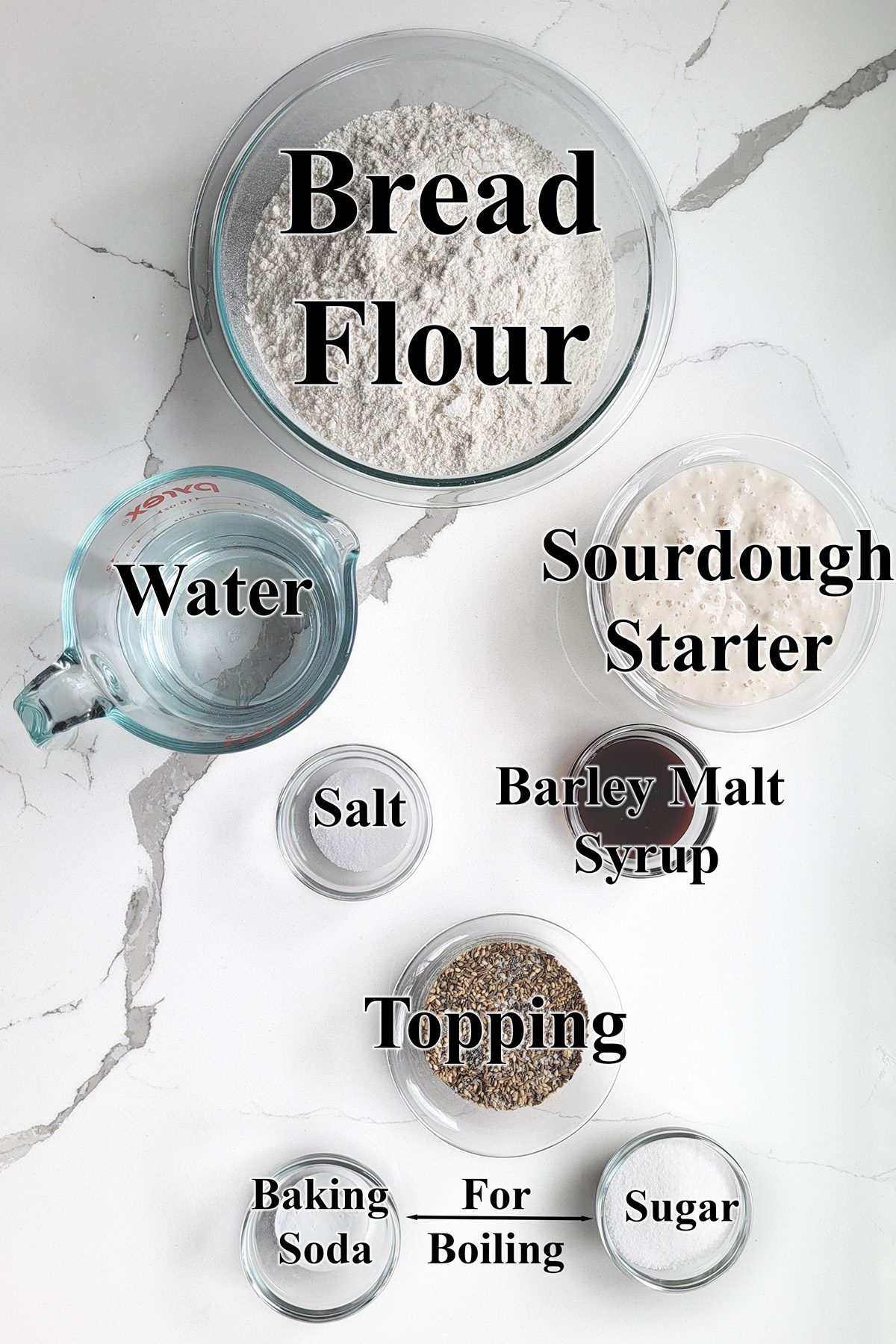
Ingredient Notes
- Bread Flour – Bagels should have a very chewy crumb from a strong gluten network in the dough. High protein bread flour develops plenty of gluten.
- Sourdough Starter – The recipe was developed using 100% hydration starter. You will need to adjust the liquid or flour in the recipe if you’re starter isn’t at 100% hydration. Your starter should be fed and active when you mix the bagel dough.
- Barley Malt Syrup – Adds a traditional slightly sweet note to the dough. You can substitute honey or a combination or honey and molasses for the barley malt syrup.
- Toppings – Leave the bagels plain or use your favorite seed for topping. You can mix seeds with salt to make your own “everything” bagel topping”. See the recipe card for details.
- Baking Soda & Sugar – For boiling the bagels. The boiling process creates the specific shiny and chewy bagel crust.
Process photos for making Sourdough Bagels
Here’s what the recipe process looks like at each stage. Refer to the recipe card below for measurements and exact instructions.
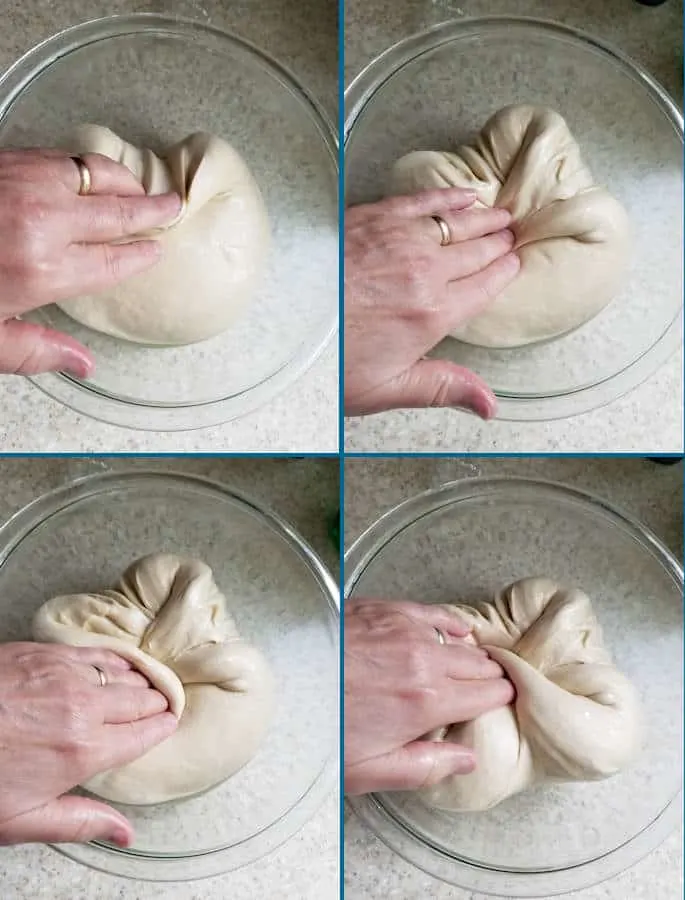
- As the dough ferments, it should be folded onto itself every hour or so to redistribute the yeast.
- Fold from each side into the middle, then flip the dough over.
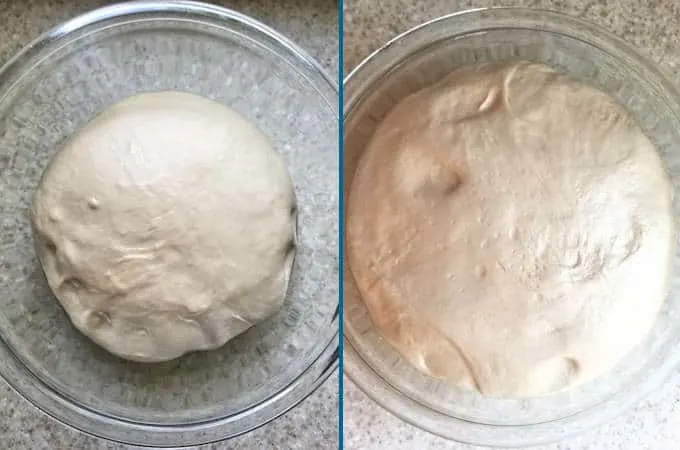
- After 30 minutes there’s not much activity in the dough (left).
- After 3 hours the dough should be active and nicely aerated (right).
- After fermentation it’s time to shape the bagels.
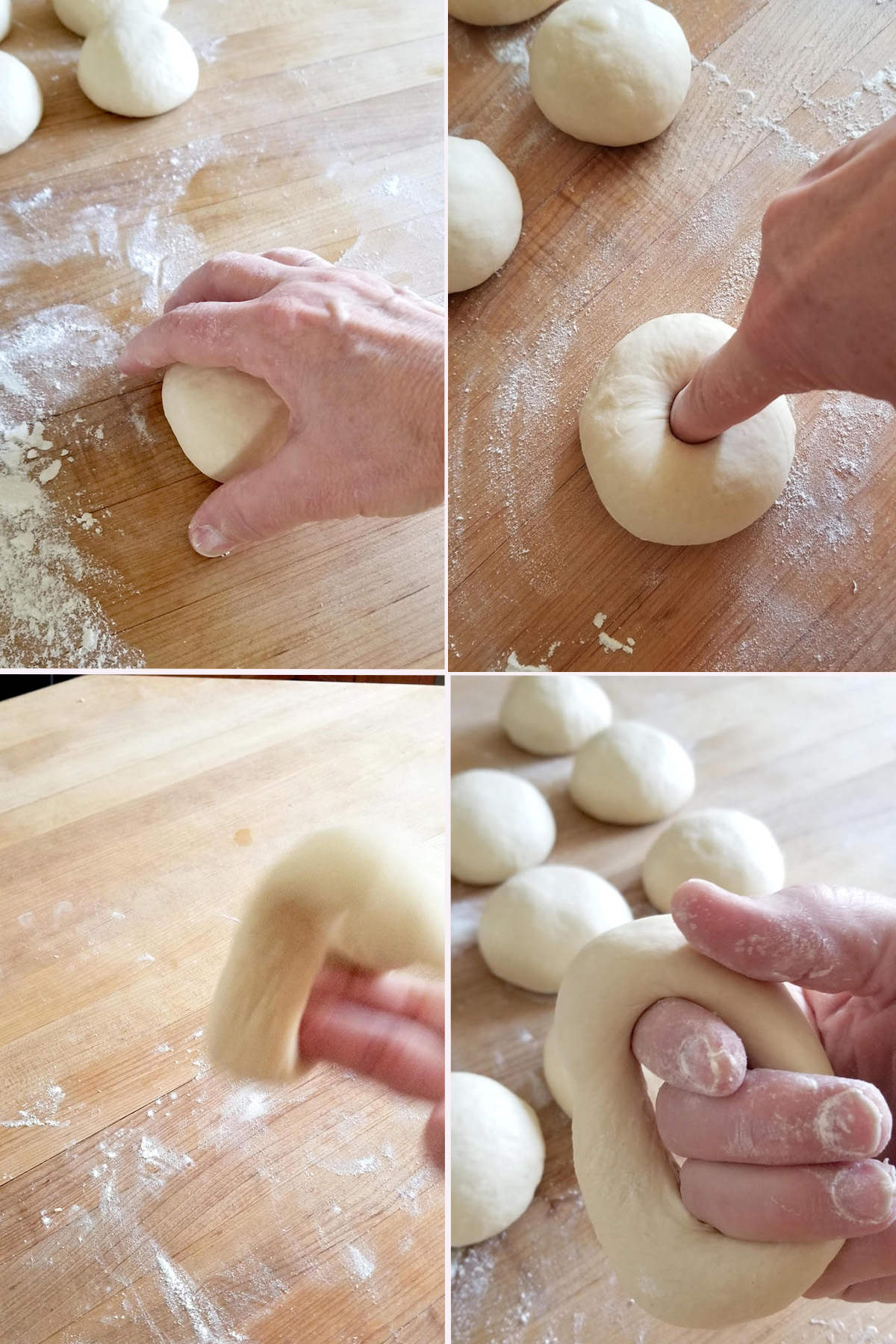
- Use a cupped hand to form the a piece of dough into a tight ball. Repeat with all the pieces of dough.
- Poke your finger all the way through the center of the ball to make a hole.
- Twirl the dough around your fingers to widen the center hole.
- Set the bagel onto the baking sheet and continue with the rest of the dough.
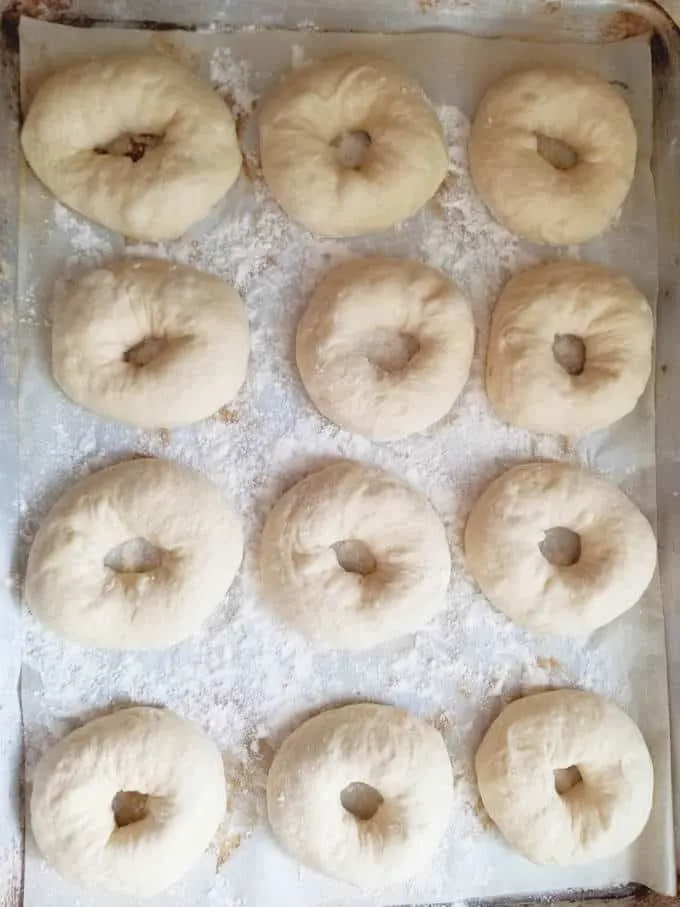
- Line the formed bagels onto a well-floured (or use cornmeal) sheet pan to prevent sticking.
- Cover the pan and place it in the refrigerator overnight.
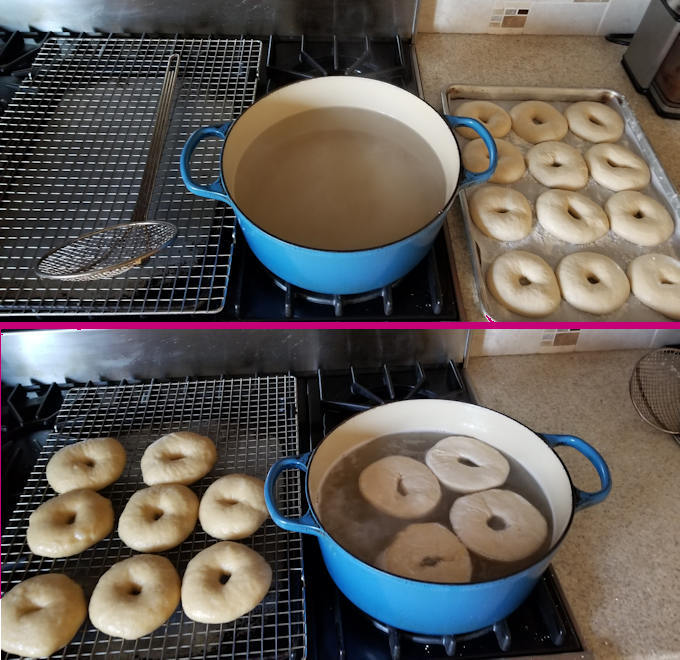
- Bring a pot of water with baking soda and sugar to a boil. Preheat the oven.
- Boil the bagels a few at a time, flipping them every thirty seconds. Boil each batch for 2 minutes.
- Transfer the bagels to a rack to drain while you finish boiling the rest of the bagels.
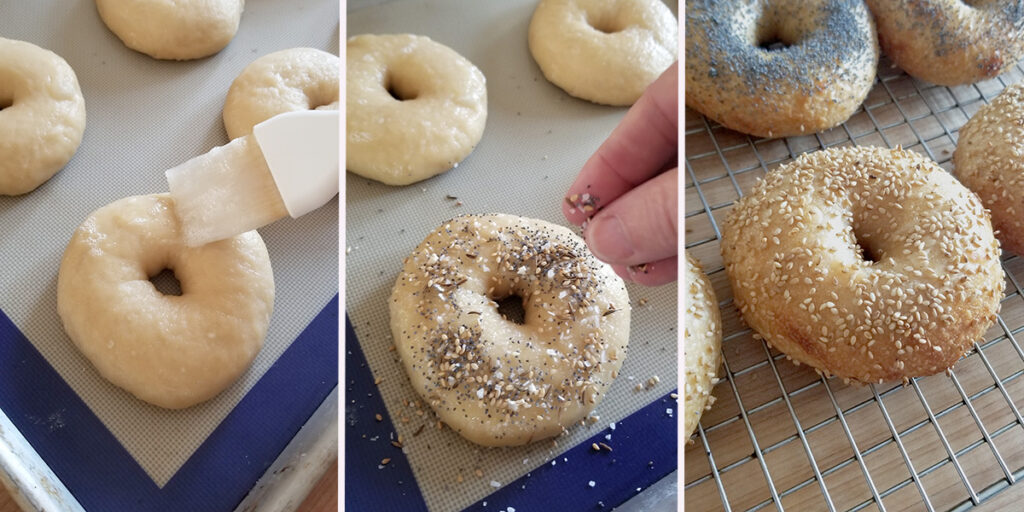
- Brush the boiled bagels with egg white.
- Sprinkle seeds or bagel topping if desired.
- Bake until the bagels are golden brown.
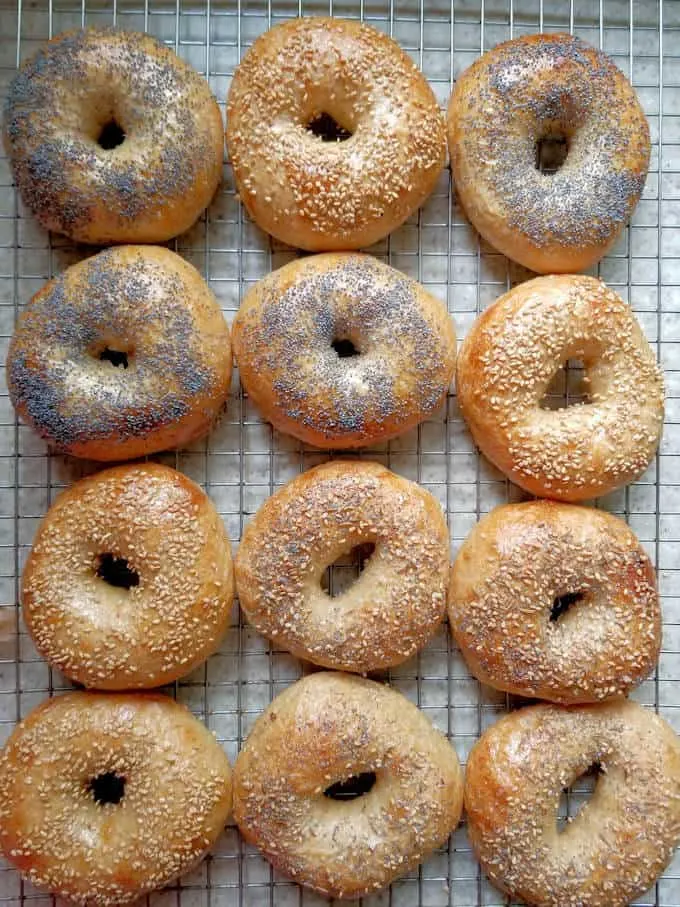
Recipe Tips
- Make sure your starter is very active and lively. I get the best results when I do two feedings in the days before making this dough. I keep several starters and use the Small Starter for this recipe because it requires two feedings before baking with it.
- To get a good bagel shape that will rise properly, you must create a tight ball of dough before making the ring. Use a cupped hand and surface friction to roll the dough into a ball. You can see how it’s done in the recipe video.
- Place the shaped bagels on sheet pan which has been sprinkled liberally with cornmeal or flour. If the bagels stick to the pan you will loose volume when transferring them to the water. I find cornmeal works best, but flour will work too.
- In the morning, take the bagels out of the fridge and leave them out until the dough comes to room temp.
- Don’t start boiling the bagels until the oven is preheated. They should go into the oven within minutes of coming out of the water.
Storage
- Bagels are best the day they are baked. For longer term storage, slice the bagels about 3/4 the way through and pack them into freezer bags.
- Previously frozen bagels are best if toasted before serving.
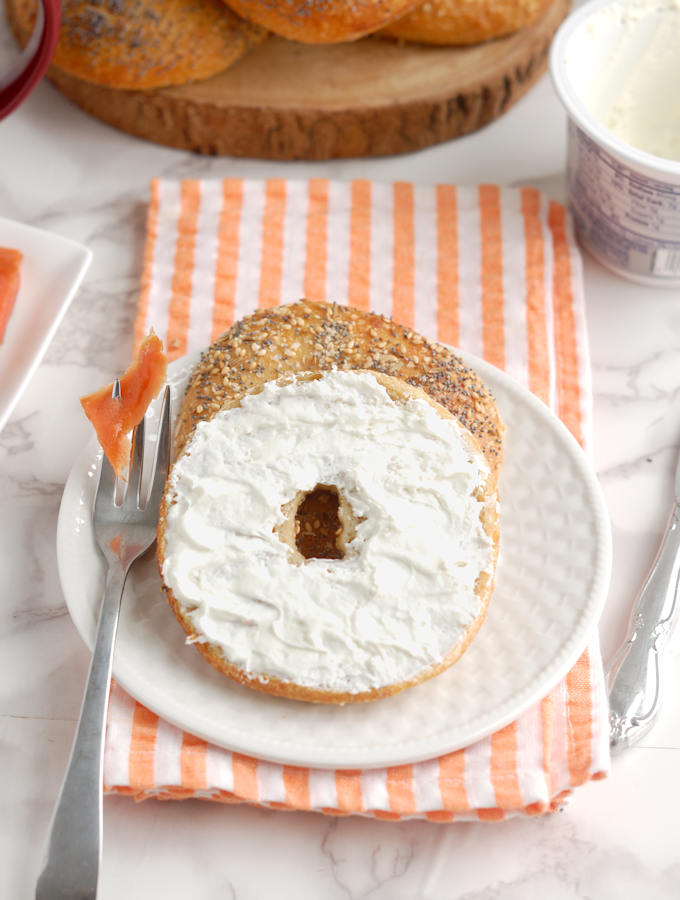
I know you hate to throw away that sourdough discard. Check out these recipes that use sourdough discard.
If you love this recipe as much as I do, please consider giving it a 5-star review.
Sourdough Bagel Recipe
Video
Ingredients
- 8 oz active sourdough starter (1 cup (100% hydration))
- 12 oz warm water (1 ½ cups)
- 22 ½ oz bread flour (4 ½ cups, divided, see note)
- 1 ½ oz barley malt syrup (2 tablespoons (or honey + molasses))
- 1 tablespoon table salt
- 2 oz granulated sugar (¼ cup (for boiling))
- 2 teaspoons baking soda (for boiling)
- corn meal (for pan prep)
- 1 egg white (whisked lightly)
- Topping (sesame seeds, poppy seeds, caraway seeds or coarse salt)
Instructions
- Combine 8 oz active sourdough starter, 12 oz warm water and 2 cups (10 oz) of the flour in a mixing bowl. Mix to form a thick batter. Cover the bowl and set aside for 30-60 minutes.
- Add 1 ½ oz barley malt syrup and 1 tablespoon table salt. Switch to the dough hook. Add the remaining 2 ½ cups (12 ½ oz) flour and mix to combine. The dough should eventually cling to the hook and start to clear the sides of the bowl.
- Knead 5 minutes on medium speed. If working by hand, stir in as much of the flour as you can, then turn the dough out onto a lightly floured surface and knead in the remaining flour. Knead 5 minutes. Form the dough into a smooth ball.
- Put the dough into a lightly oiled bowl, turning once to coat the dough. Cover the bowl and set it aside at room temperature. After 30 minutes uncover the bowl, lift one side of the dough and fold it into the middle of the dough. Repeat with the other three sides of the dough then flip the dough over. You're basically turning the dough inside-out to redistribute the yeast. Cover the bowl and repeat the procedure every 60 minutes for a total fermentation time of about 3 hours. The dough should be lively, elastic and airy. If the dough is still sluggish give it another hour or two at room temperature.
- Line a baking pan with parchment paper then generously sprinkle the paper with cornmeal (or flour). Turn the dough out onto a lightly floured surface without kneading out the air. Divide the dough into 10 even pieces. Use a cupped hand to roll each piece into a smooth, tight ball.
- To form a bagel, poke your finger all the way through the center of a ball to make a hole. Use two fingers to gently open up the hole. Continue gently stretching to form the bagel or twirl the dough around your fingers to widen the center hole to 1 – 1½" wide.
- Place the bagel on the prepared sheet pan and continue to form the remaining bagels. The dough will probably spring back a bit so you can go back and re-stretch the holes once you're done forming all the bagels. Cover the pan with plastic wrap. If the dough and the ambient temperature is on the cooler side, leave the shaped bagels at room temperature for 30 minutes then place the pan in the refrigerator overnight. If the dough and ambient temp is warmer and the dough is quite active, place the bagels into the refrigerator without leaving them out for 30 minutes.
- In the morning take the bagels out of the refrigerator and bring them to room temperature.
- Preheat the oven to 450 °F. In a large pot combine 1 gallon of water with 2 oz granulated sugar and 2 teaspoons baking soda and bring it to a boil. Reduce the heat to keep the water at a rolling simmer. Set a cooling rack over a sheet pan or kitchen towel and place it next to the stove. Line two half-sheet pans with parchment paper or silicone baking mats and generously sprinkle with corn meal.
- Once the oven is preheated, you're ready to boil. Gently lift a bagel off the sheet pan and lower it into the water, bottom side down. Depending on the size of your pot, you can boil 3-4 bagels at a time. Boil the bagels for 30 seconds then flip them. Boil the other side for 30 seconds. Repeat the process again for a total of 2 minutes boiling time. Remove the boiled bagels from the water and set them on the cooling rack to drain.
- Place 5 of the boiled bagels on each sheet pan. You could fit them all on one pan but they may stick together as they bake.
- Brush the bagels with egg white. Add the topping(s) of your choice. To make "everything" bagels combine a tablespoon of each of sesame seeds, poppy seeds & salt with a 1/8 teaspoon garlic powder and onion powder. Bake until golden brown, about 20 minutes.
Would you like to save this recipe?
As an Amazon Associate and member of other affiliate programs, I earn from qualifying purchases.









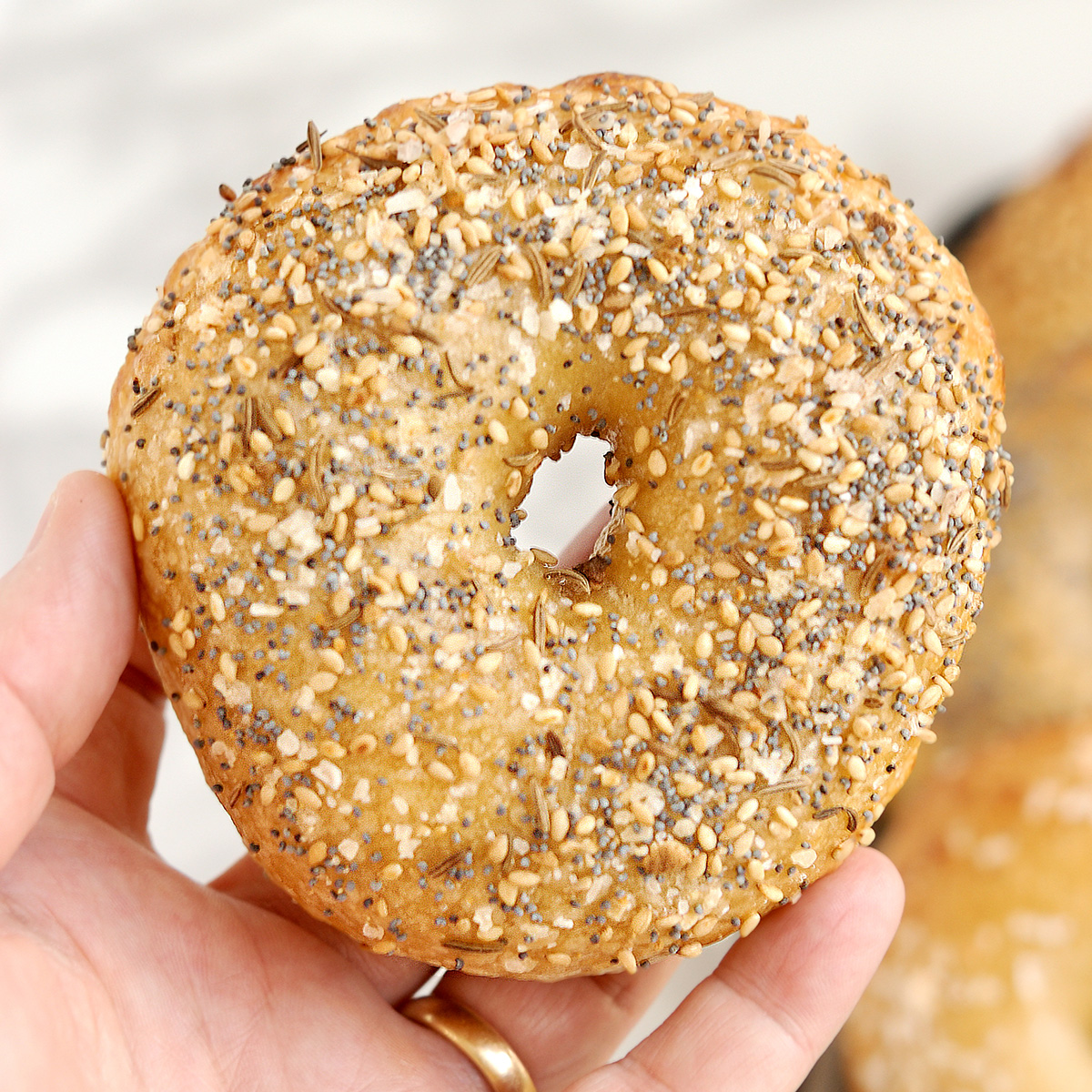
Eileen, I wanted to clarify one thing: after 5 minutes in stand mixer, I have been kneading by hand for 5 minutes. Is this correct? Thanks,
Jim
There no need to continue kneading after kneading on the mixer for 5 minutes. The dough will continue to develop the gluten during the long fermentation.
Question: Instead of forming bagels then refrigerating overnight, can I refrigerate the dough overnight then form bagels. That’s easier for me in terms of available refrigerator space.
Yes. They will take longer to rise and be ready for boiling since you’ll knock out any air that formed overnight. But, otherwise, not a problem.
@Eileen Gray,
Thank you Eileen. Quick reply much appreciated. Simple, but critical info for this beginner!
Jim
@Jim Wintner, Eileen, where do I find a link to the video?
If you’re running an ad blocker the video won’t run since it is preceded by an ad. If you turn off your ad blocker you should see it. If you want to rewatch the sourdough bagel video you can reload the page and it will run again.
@Eileen Gray, Thank you, I was finally able to pick it up from the rotation of videos that show lower right of screen.
I just finished a batch. I measured the ingredients to be as close to yours as possible. At kneading, the dough was sticky and I had to flour my hands to work the dough. I then went through the sequence of folds/rises you indicated, plus one hour more. I put the dough in the fridge unshaped, as planned. In the morning it sat out for a couple of hours, then I shaped the bagels where I had a little concern that the surface of some was too rough (I have photos), but the dough handled fairly well and I could shape rings without feeling the dough might pull apart.
With the boiling I confronted my first real red flag: the bagels sank to the bottom and tool some coaxing to come up. They never did completely, instead they rolled around in the boiling water exposing all sides.
I baked them approx 25 min. I had a few where the holes closed up (I can fix that) but, otherwise they look good and I am about to cut into one ……
a few minutes later: tastes pretty good! Probably still a little too warm, but you know how hard it is to wait! Thanks for your advice. Any suggestions welcome.
@Eileen Gray, PS
I just read through several months of comments and see that both sticky dough and non floating are common and that you are in the same range. I wanted to add that I did not consider my bagels fragile when being transferred to boiling. And they did rise very well in the oven.
A remaining question: how do you identify your starter as highly active?
Thank you again!
I have found with this recipe that the quality and condition of your starter is extremely important. I keep a small starter, which needs 2 feedings before I can use it. I use that for bagels because the double feeding means my starter is fresh, well-fed and happy before I make the dough. The starter is highly active when it has just reached the peak of it’s rise, or just after it begins to recede. If you watch your starter you can see that when it’s first fed (equal weights of starter-flour-water) the texture is like a very thick pancake batter. After going several days or a week without feeding the same starter is probably more like a crepe batter. So you can imagine the stage at which you use that starter could make a big difference in the texture of the bagel dough. Older starter has weaker gluten and is more acidic. Both those things could make a wetter and heavier dough.
Hi Eileen – so excited to make these!! I wanted to see beforehand if there was any reason you don’t use barley malt syrup when boiling, instead of sugar?
I’ve made bagels just once before, but not sourdough, and used the syrup when boiling. I wanted to try that again but wanted to make sure there wasn’t a reason for just using the sugar. Thank you in advance!!
You can use syrup instead of sugar for boiling.
@Eileen Gray, thanks so much!
Inhave tried other sourdough bagel recipes but this is, hands down, the best one I’ve tried. This is my GO TO recipe!
I think the wetter dough is the secret!
I live with a bagel monster, and he does not want any other bagels, anymore. His friend (whose father was a baker) tried them last week and, now, also wants only these bagels. (You are to blame for this!!)
I don’t know why I feel I have to apologize for people who have no respect and manners whatsoever. I agree with everyone who posted about this rude person.
Obviously, he is perfect and any mistakes would not be due to anything he did. Hmmm…
I can only say thank you for sharing your recipe. It works for me. In fact, I’m just waiting to roll them and poke etc..
Fresh bagels tomorrow, yummy!!!
I made these bagels this morning and they turned out BEAUTIFULLY! It’s cold here, so I added all the 30-minute additions like you suggested. I was a little worried I pushed it too fast for the ambient temperature — I meant to start them around 3 pm and didn’t get to it until 5:30, but they still turned out great! When I boiled the bagels, they didn’t float, which was really weird — I’ve never had that issue with bagels before. I was worried they weren’t proofed long enough, but they still came out of the oven with good color, a great crumb, texture and hydration. I’ll just chalk it up to cold weather and leave a little more wiggle room for myself next time ;). I used honey/molasses in lieu of malt, and added a tiiiny bit more flour (the cup measurements in the recipe instructions made it difficult for me to tell if my measurements were correct – I always prefer grams!) because the dough was sticky when I kneaded by hand, and that helped a lot. Other than that, I stuck to the recipe exactly.